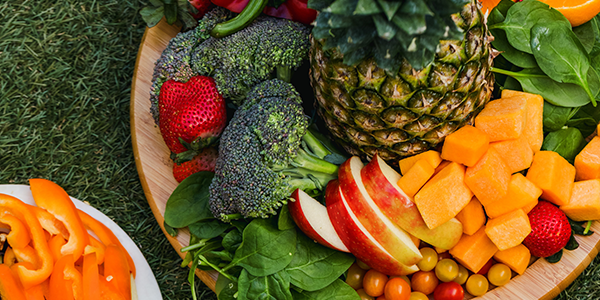At some point along your health journey you’ve likely been encouraged to eat more fruits and vegetables. While certainly good advice, it is not always the most useful advice. Which fruits and vegetables? Is there a difference? How many servings? How do I make vegetables taste good? How do I find time to prepare them? These questions inevitably pop up and achieving success requires the development of a practical strategy. Along with increasing consumption, this strategy can address avoidance of waste and acknowledge that fruits and vegetables are not equally beneficial.
As much as people would love for it to be true, fruits and vegetables are not interchangeable. The USDA has done a bit of dis-service in lumping the two together, suggesting that serving sizes should be roughly the same for both. Of course fruit will always be a better choice than sugary treats, but MyPlate.gov actually lumps fruit juices and dried fruits into the same category as whole fruit. That Naked Juice Green Machine “no sugar added, 100% fruit juice” smoothie that sounds so healthy contains a whopping 53g of sugar and 63g total carbohydrates. That’s more than a can of coca cola! Just one of these will have many times more servings of fruit than you should be consuming in a day. With most of the fiber stripped away through the juicing process, consuming these spikes blood sugar levels rapidly. If you’re trying to manage your glucose levels and weight, this can be very problematic. We’ll explore the role blood sugar has in weight management more in the future, but for starters the advice to eat more fruits and vegetables should be better stated as – increase vegetable consumption to 3-5 servings per day, ideally non-starchy, and consume 1-2 servings of fruit per day from whole food sources. Good non-starchy vegetables include leafy greens, the cruciferous family (broccoli, cauliflower, cabbage .. .) and can be consumed to your heart’s content. Now that we have narrowed our attention, let’s dive into the barriers to entry and some practical tips toward working more vegetables into your eating strategy.
Planning is Key
As the saying goes, the road to hell is paved with good intentions. Before you go buy every vibrant fruit and vegetable you see, let’s consider why this seemingly simple objective to eat more fruits and vegetables is often difficult to implement and plan accordingly.
We’ve all done it at some point. We buy a bunch of fresh produce, only to have it sit in the bottom of the fridge for a week. By the time we get to it, we find a mushy pile of rotten food. What happened? You had every intention of eating those delicious fruits and veggies. The wasted time, money and energy can make it seem like a lost cause, but the problem is often a lack of planning. Tackle this head on by choosing a day and time for preparing vegetables in an efficient manner. Here are some areas to focus on in the beginning stages.
- Food Prep: Ahead of the week, wash and chop your greens and non-starchy vegetables to store in the refrigerator. Most low moisture vegetables can also be frozen if you don’t intend to eat them within a week. Check out this handy guide on freezing vegetables here. Reusable food storage containers can be very helpful as well.
- Purchasing ripe vs unripe: We recommend some of both in order to have some on hand to be consumed in following 1-2 days while the rest continues to ripen for consumption in days that follow. Nearly all fruits and vegetables will have the best flavor when picked ripe. Get to know which vegetables turn quickly and prepare those early in the week. Firmness and color are good indicators of freshness.
- Cook in batches: Roast or grill a large batch of vegetables for the week. You can dress or season them differently depending on the dish you are adding them to, or make them the main course. Broccoli, cauliflower, brussel sprouts, onions, zucchini and asparagus all taste amazing when roasted. Check out these ideas for sheet pan dinners. Some are a bit more decadent than others so choose wisely.
- Create a menu: A rough menu for the week that prioritizes prepped veggies that tend to turn quickly can also help you plan which proteins may need to be defrosted ahead of time.
Time Saving Tips
Make it a habit of roasting a big sheet pan full of vegetables each week. Roasted vegetables pair well with almost any main dish and are a great way to use up leftovers that don’t have many days left of freshness. Vary the flavor profile with sauces, dressings or seasonings that compliment your ingredients.
The key to doing this well is to group veggies by density and texture and cut them into similar size pieces so they cook at the same rate. For example group broccoli, cauliflower and brussel sprouts – or zucchini, onions, and bell peppers together. More dense and starchy vegetables such as carrots and parsnips will take much longer to cook and caramelize.
Lightly coat them in Avocado or coconut oil and season well with salt and pepper or your favorite spices and hearty herbs. Make sure they are not over-crowded in the pan as they will steam and overcook before browning if you do. Roast at 425F for 20-40 minutes depending on the density of the veggies. Stir once or twice while cooking and remove from the oven when they can be easily pierced with a fork and are golden brown along the edges. That golden brown caramelization is a big flavor bonus so be patient to let it develop in the oven, you’ll smell it when it’s right.
Ricing and Food Processing
Ricing vegetables has become an incredibly popular trend over the last few years as a way to cut down on starches while still enjoying some of your favorite dishes. Simply use a food processor or a grater to chop up your chosen vegetable into tiny pieces that can be used for everything from faux mashed potatoes to pizza crust. Some of the best vegetables for ricing are cruciferous varieties like cauliflower, broccoli, cabbage and brussel sprouts.
The non-vegetable lovers guide to eating more vegetables
What if you flat out don’t like the taste of most vegetables? Whether it’s taste or texture, there are many ways to help make vegetables more palatable. Depending on your current eating strategy, you may need to be patient with yourself and understand that your palate will need a bit of retraining to appreciate the freshness of raw or cooked vegetables. Choose ones that you can tolerate, and add them into meals more often, even breakfast. Try them raw, cooked, chopped fine, and coarsely chopped. Take some time to learn the doneness you prefer to enhance the taste and texture. Many vegetables will lose all appeal when overcooked. When
you get bored, it’s time to try something new.
Modulating Taste
A genetic sensitivity to bitter compounds can make brussel sprouts disgustingly inedible to some people. While our olfactory sense of smell can detect thousands of aromatic compounds, our taste buds can only detect 5 basic basic tastes – Sweet, salty, sour, bitter, umami. The beauty of cooking is that you can modulate the bitterness in vegetables by adding salt, acid, sweetness, umami or fat. Could you imagine a salad without dressing? Not only does fat help improve taste, but fat soluble vitamins such as D and K need fatty acids as a transport to be absorbed properly. Check out these 10 DIY salad dressing recipes for a great place to start, many of which can be used as a marinade as well. Aside from the dressings mentioned, keep spices and aromatics stocked in your kitchen such as lemons, garlic, onions, herbs, and spices. These will add a lot of flavor but not many calories. Also many bitter greens will benefit from a light blanch (a quick bath in boiling water) before seasoning to help leech bitter compounds out. Be careful not to overdo it as boiling will also remove nutrients. Overall keep in mind that just the cooking method can be the deciding factor whether you enjoy a particular vegetable. You may hate broccoli steamed but love it roasted and slightly caramelized.
Summary
Increasing your vegetable consumption can seem impossible at times, but having a plan and sticking to it can be really beneficial. Be open to trying new things and experimenting to find your preferred cooking method for vegetables that you like. Enjoy fruit in moderate amounts and be careful with juices and smoothies if you are trying to manage blood sugar levels and lose weight. Fruits and vegetables are not created equally, but with the right approach we can be mindful about the best choices for our health and eating strategy.



















